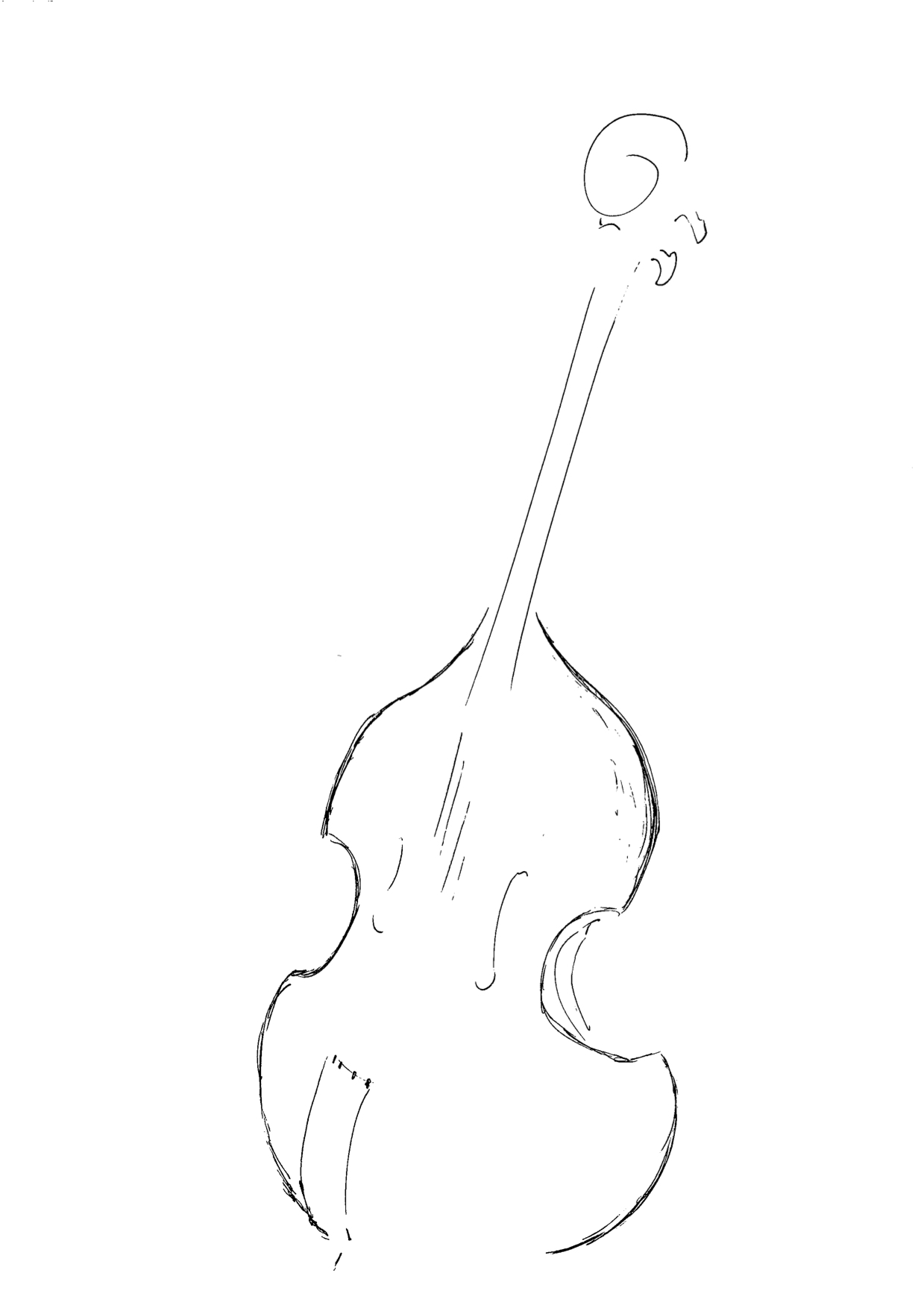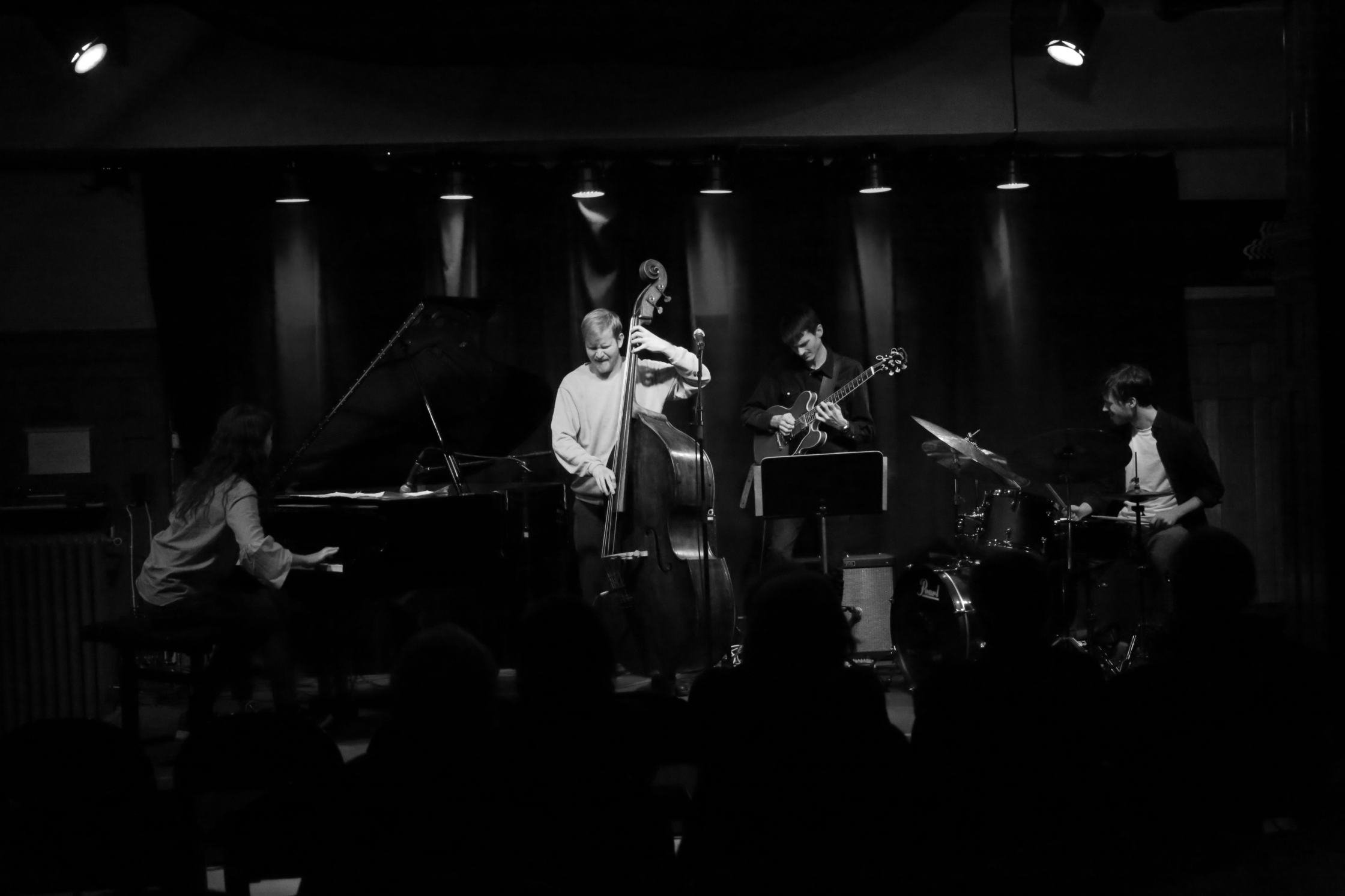I thank you as a reader for your time and I do hope that you have found this thesis an enjoyable read. I've learned so much during the two yers I have spent writing this thesis and I very much look forward to continue my work on a deeper level in the future, as a bass player as well as a human being
Daniel Andersson
june 2020
references
Klein, Julian. 2010 Gegenworte 23, Berlin-Brandenburgische Akademie der Wissenschaften
Tyboni, Börje. 1996 Noter, Gehrmans Musikförlag.
Discussion
When discussing my thesis with friends and colleagues, I found that I always described my work - in wide terms - as "a project where I examine the possibilities of chord playing on the upright in jazz and world music, or music with traditional western chords as it's basis." After finishing the Theory and implementation part of this thesis, I started thinking about if my playing had changed at all when in a "regular" playing situation. I started to analyze clips and recordings from the inception of this thesis to try to find if I had started to incorporate the techniques described in the Theory and implementation part of this thesis. Were the techniques I had practiced and examined after all limited to compositions where such techniques were bluntly written out? Or had I started to incorporate the techniques in my everyday playing?
This led me to ask myself yet a few more questions:
Are the techniques better suited for certain sub-genres of the music I play? Or do they work in all types of music, regardless of the "consensus" regarding the sound of the genre? What choices do I make in regards to my own playing when faced with music that has a clear "pretetermined sound"?
Going back to the recording of "Get With", discussed on the previous page, The use of artificial harmonics lends itself well to the composition and really sets a mood to the song. Even though "Get With" has a sound reminiscent of older, traditional jazz tunes the technique blends with the sound and complements the composition in a - for me - meaningful way. This might, however, be because the technique creates a sound that's - of all the techniques described in Theory and implementation - isthe closest to ordinary pizzicato playing.
I eventually came to the conclusion that even though the techniques are possible to utilize in any given musical situation, the disctinct timbre the techniques provide will most likely change the overall sound of the band (the band will either choose to play in a more open, lyrical way, or the timbre of the techniques will feel so detached from the rest of the over arching sound that I would eventually resort to more traditional bass playing).
The purpose of this discussion is not, however, to grade or decide if one sound is superior to another, no matter the genre. As I stated in introduction, what I aimed for was to "research the possibilities of using the harmonic spectrum of overtones in conjunction with ordinary pizzicato playing in order to find new ways of approaching the upright bass as a chord instrument. I do believe that duiring the course of writing this thesis, I have done just that, and developed greatly as a bass player because of it.
Even if I still play music in which I don't use these techniques at all, I firmly believe that having access to them creates a different approach - and a richer understanding of the instrument and it's possible roles - than what I had before.
I would now like to say a few words to sum up this master thesis.
During the course of my work I have truly rediscovered myself as a bass player, and while I have indeed researched and tested the techniques discussed in Theory and implementation, I have also found a new love for "ordinary" bass playing. Listening to recordings I have made during my years as a student at HSM I was delighted to find that I started out my first year as a very traditional bass player. My technique was lacking in more than one area, and I was so focused on learning and exploring the instrument and fixed genres that I had little time to reflect on my own development and progress.
I will now, to end this thesis, showcase a few recordings I have made, one for each year of my studies. If listening closely, one can clearly hear shifts in focus from year to year: Starting out as a very traditional player, finding my way into harmonics and chord playing, to slowly but steadily integrate the two approaches and - finally - ending up a more well rounded musician with a completely new catalogue of techniques and experiences.
To the right of this text are five different recordings, one for each year I have studied at HSM. I hope that listening to these will bring some clarity into my development as a musician and bass player, and with these recordings I will finally try to answer the questions I asked myself in the introduction of this thesis.
2.
My second year I started playing in a duo setting with singer Tora Runevad Kjellmer. This is by far the single most important musical excerience I've had as a bass player, seeing as it forced me to approach the bass in a completely different way than I had done before. On this recording I have started to play chords on the bass, and things such as timing, listening, following as well as leading have drastically improved from the recording above.
3.
During my third year my trio Thistle May recorded an EP where this was one of the songs. Since I had been practicing different chord voicings and started to incorporate harmonics into my playing, my intonation is better here, and I have continued to develop my confidence as a rhythmical player. The chords feel more thoughtful here, I think, and had probably "landed" a bit more in my playing than the previous year.
5.
And finally the last example, and what better way to end a master thesis than with a recording from my exam concert, recorded at Nefertiti Jazz club in february of 2020. Now, to finally answer the question I asked in the beginning of this thesis: Is the upright bass viable as a chord instrument, and how can one adapt the overtone spectrum of harmonics in conjunction with traditional playing to approach the bass as such. Now, two years later, I can say with confidence that not only is the upright bass versatile enough to be used as a chord instrument, but approaching the bass in such a manner has helped me achieve a level of technique, confidence and greater understanding of the instrument than I had before. I will of course continue working to improve myself and, if possible, the people around me by researching this subject further in the future. But for now, I will let the music speak for itself.
1.
My first recording as a student as HSM. The song is called Atlas and dedicated to my brother.
Marcus White plays the guitar and Adam Ross plays the drums.
To reflect: My playing is not bad per se, but as we will hear from later recordings there is definately a lack of "leadership", variation in the comping as well as dynamics. With all this considered though, I am still happy with the recording.
4.
My first semester as a master student saw the recording of icelandic pianist and band leader Ingi Bjarni Skulason’s first quintet recording. This tune in particular, in my opinion, shows substancial growth from myself as a bass player. My technique and intonation is far better than before thanks to the hours practicing chord playing and harmonics, and as a result listening to my playing feels a lot more relaxed - the margin for error has been trimmed which makes way for an easier listen, so to speak.

